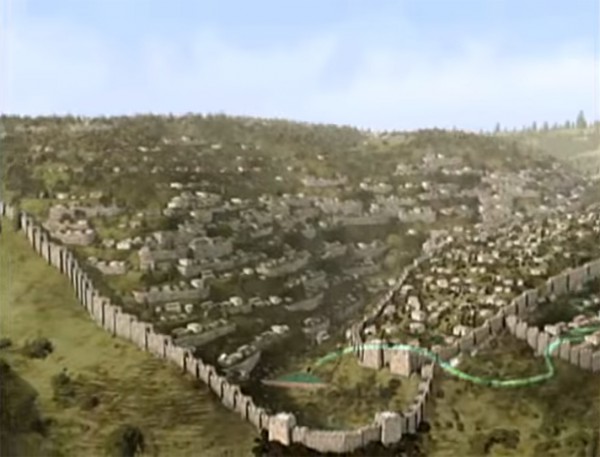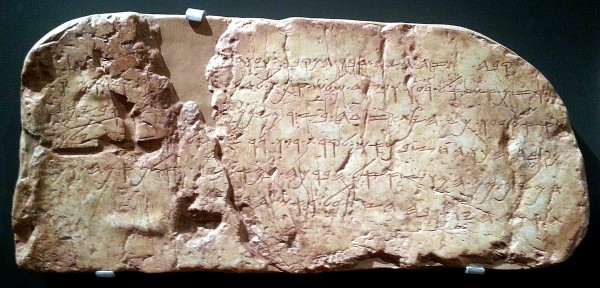
A view of the Kidron Valley, with the Mount of Olives across the valley to the left and the slope of the City of David on the right. The Gihon Spring emerges from the foot of this slope.
“I have chosen Jerusalem for my Name to be there, and I have chosen David to rule my people Israel.” (2 Chronicles 6:6)
As God’s chosen Holy City, Jerusalem has been the heart of the Jewish People for thousands of years.
As one of the world’s oldest continuing cities, Jerusalem has also been irresistible to archaeologists.
“Since the middle of the 19th century, archaeological digs have been undertaken in and around the Old City, ever increasing in scope and improving in scientific methods. Layer upon layer of past eras has been uncovered, bearing out history, and also revealing secrets,” says Israel’s Ministry of Foreign Affairs.
Prior to the end of the 19th century, archaeologists focused on treasure-hunting and small antiquities.
Toward the turn of the twentieth century, their focus morphed into a desire to uncover the culture and customs of those living before us.
Perhaps some of the most exciting archaeological discoveries in the area of Jerusalem in recent times involve the Gihon Spring. Its waters are referred to in several Bible stories.
In 1 Kings 1, for instance, Gihon is mentioned in relation to Solomon being anointed as king.
“Take your lord’s servants with you and set Solomon my son on my own mule and take him down to Gihon. There have Zadok the priest and Nathan the prophet anoint him king over Israel.” (1 Kings 1:33)

In 2004, the Ir David Foundation uncovered stone steps that were part of the Second Temple period Pool of Siloam
David Captures His Capital
“The Jebusites said to David, ‘You will not get in here; even the blind and the lame can ward you off.’ They thought, ‘David cannot get in here.’ Nevertheless, David captured the fortress of Zion, the City of David.” (2 Samuel 5:6–7)
In ancient times, King David chose Jerusalem as the capital.
When David approached Jerusalem with his battalion, intent on conquering it, the Jebusite king thought his mountaintop fortress was impenetrable. He saw swift defeat for David’s army, and smugly told him, “Even the blind and the lame can ward you off.” (2 Samuel 5:6)
Perhaps this inspired David’s son Solomon to write the proverb, “Pride goes before destruction and a haughty spirit before a fall” (Proverb 16:18), since the Jebusites’ pride was indeed their downfall.
We read that the soldier Joab first entered the city by accessing the hidden, pitch-dark, narrow corridors of the underground water channels where the Gihon Spring flowed. (2 Samuel 5:8)
After scaling a vertical shaft into the city, Joab likely led the procession to open the city gates where David’s troops entered en masse.
For his victorious entry, David awarded Joab the title of Commander-in-Chief:
“David had said, ‘Whoever leads the attack on the Jebusites will become commander-in-chief.’ Joab son of Zeruiah went up first, and so he received the command.” (1 Chronicles 11:6)
Underground Secrets Revealed
“There is a river whose streams make glad the city of God, the holy place where the Most High dwells.” (Psalm 46:4)
The Gihon Spring was Jerusalem’s main water source, located outside the city walls on the west bank of the Kidron Valley.
Three main covered water systems brought water from this spring to the city:
- A Bronze-Age (2100–1550 BC) aqueduct cut 20 feet into the ground, perhaps existing during the time of Melchizedek.
- Hezekiah’s Tunnel, also called Siloam Tunnel, replaced the Bronze Age aqueduct. It was carved through the rock under the City of David.
- Warren’s Shaft, which runs from within the old city to the upper part of Hezekiah’s tunnel.
Though the tunnel system was initially discovered in the 17th century, in the early part of the 19th century, the Shiloach (Siloam) Tunnel, also known as Hezekiah’s Tunnel, was officially explored.
The water from this channel outside the walls of Jerusalem may have been important for agriculture. Openings cut over a wide span in the eastern fortifications are thought to have irrigated the fields of the Kidron Valley.
Perhaps, they also eventually watered the very gardens that were the inspiration for Solomon’s poem, the Song of Songs.
“My lover has gone down to his garden, to the beds of spices, to browse in the gardens and to gather lilies.” (Song of Songs 6:2)
Gihon Spring Meets the Pool of Siloam
“The Fountain Gate was repaired by Shallun son of Col-Hozeh…. He also repaired the wall of the Pool of Siloam, by the King’s Garden, as far as the steps going down from the City of David.” (Nehemiah 3:15)
The name Gihon is derived from the verb gayach, which means to gush or burst forth.
The name reflects the flow of the spring, which continues to this day as an unsteady flow, surging at times, depending on the season and amount of rainfall.
Groundwater accumulates in the spring via a subterranean cave. Whenever that cave fills, it empties through cracks in the rock and is siphoned to the surface.
This necessitated that the water be accumulated in a rock-hewn pool—the Pool of Siloam—so that the water was accessible when the spring was not gushing forth.
This Pool of Siloam, located on the southern slope of the City of David, is mentioned several times in Scripture. In fact, in the Gospel of John, Yeshua (Jesus) healed a man blind from birth by anointing his eyes with clay and telling him to wash in the Pool of Siloam (John 9:6–7).
“‘Go,’ he told him, ‘wash in the Pool of Siloam’ (this word means Sent). So the man went and washed, and came home seeing.” (John 9:7)

These impressive steps are part of the Jerusalem pilgrim road, which led from the Pool of Siloam to the Temple Mount
In 2004, workers for the Ir David Foundation, an organization that funds many of the archaeological excavations in the City of David (Ir David), discovered steps leading down to a lower trapezoidal-shaped pool called the Pool of Siloam, which is fed with water by a channel from the Gihon Spring.
The pool is large compared to others found in the Holy Land. It accommodated thousands of pilgrims journeying to Jerusalem for the celebrations of the Shalosh Regalim—the Three Pilgrimage Festivals of Pesach (Passover), Shavuot (Feast of Weeks), and Sukkot (Feast of Booths). (Exodus 23:14–17)
The pool was more than just a place for refreshing and re-hydrating. It was a mikvah, a public bath for cleansing that rendered the pilgrims ritually pure before they ascended a quarter mile (600 m) on the Jerusalem pilgrim road to the Temple Mount to worship God.
Moreover, water from of the Pool of Siloam was carried up the pilgrim road to the Temple for the Water Libation Ceremony during the intermediate days of the seven-day festival of Sukkot.

This Ir Foundation mockup of ancient Jerusalem depicts Hezekiah’s tunnel, represented by a curved green line, which runs under the City of David, down its southern slope, and into the Pool of Siloam. (City of David YouTube capture)
At the ceremony, amidst jubilant dancing, singing, trumpet playing, and palm branch waving, a priest poured water over the southern altar.
Water from the pool expressed hope for rain to produce an abundant harvest and had Messianic implications, perhaps pointing to the time when “the earth will be filled with the knowledge of the Lord as the waters cover the sea.” (Isaiah 9:11)
In fact, Bible prophecy says that the nations will come to Jerusalem during Sukkot when Messiah reigns on earth. Rain will be withheld from the countries who do not come to worship the King (Zechariah 14:17).
Yeshua well understood the Messianic expectations and the significance of the water associated with Sukkot. On the last day of the festival, He declared to pilgrims gathered in Jerusalem:
“If anyone is thirsty, let him come to me and drink. Whoever believes in Me, as the Scripture has said, streams of living water will flow from within him. By this He meant the Spirit, whom those who believed in Him were later to receive.” (John 7:37–38)
Upon hearing Yeshua make this statement, some realized that He was the Messiah (John 7:41).
Hezekiah’s Amazing Tunnel
“It was Hezekiah who blocked the upper outlet of the Gihon spring and channeled the water down to the west side of the City of David. He succeeded in everything he undertook.” (2 Chronicles 32:30)
Because of archaeological digs, we now know of two channels underneath the City of David, one from the time of Melchizedek (2,100 BC, during Abraham’s time) and another from the reign of King Hezekiah (700 BC).
Hezekiah realized that the city would need a secure water supply in the event of a siege by the Assyrians.
He decided to block the part of Gihon outside the City of David and to tunnel a 1750-foot (530 m) aqueduct under the city (2 Chronicles 32:1–5).
This would keep the water inside the city and prevent the enemy from having access.
According to a written inscription discovered in the tunnel, two teams worked on the tunnel, each team beginning at opposite ends, cutting out the bedrock and meeting in the middle.
This was an amazing feat when you realize that the tunnel was not cut on a straight line but curves back and forth.
Today, due to archaeological excavations, Hezekiah’s Tunnel, which replaced the tunnel from Melchizedek’s time, can be walked through from end to end.
“As for the other events of Hezekiah’s reign, all his achievements and how he made the pool and the tunnel by which he brought water into the city, are they not written in the book of the annals of the kings of Judah?” (2 Kings 20:20)

This passage, called the Siloam Inscription, was inscribed into the rock in Hezekiah’s Tunnel. It tells how the workers chiseled out the tunnel, starting at opposite ends and meeting in the middle.
The Roman Siege of the Tunnel
“Do you see all these great buildings?” replied Yeshua (Jesus). “Not one stone here will be left on another; every one will be thrown down.” (Mark 13:2)
Archaeological finds inside Hezekiah’s water channel between the Pool of Siloam and the Temple Mount highlight the period of the Jewish revolt against the Romans in 70 AD.
It seems that the Romans deliberately smashed sections of it in order to access the underground tunnel where many Jews were hiding, hoping to survive the onslaught.
Finds of unbroken ceramic cooking pots and coins dating back to this period confirm the account of Josephus regarding this tragic time:
“. . . the Romans slew some of them, some they carried captives, and others they made a search for underground, and when they found where they were, they broke up the ground and slew all they met with. There were also found slain there above two thousand persons.” (Wars 6.429–6.430)
After the siege, the waters stopped flowing through the channel as debris from the destruction held back the flow.
Today’s Water Supply in the City of David
In ancient times, the Gihon Spring was sufficient to supply the City of David. Back then, the city only spanned 11 acres. In contrast, Jerusalem today covers 31,000 acres.
Obviously, the Gihon is no longer sufficient to meet today’s needs. Today, Israel obtains 30% of its water from the Sea of Galilee, which originates from the Jordan River.
The arid climate in Israel and the drought conditions that have largely persisted since the mid-1990s forced the Israeli government to initiate a long-term solution to providing sufficient clean drinking water to the entire state of Israel.
In 2013, one of the largest desalination plants in the world opened 10 miles north of Tel Aviv in Sorek. which transforms 150 million cubic meters of sea water a year into drinking water. This plant along with plants in Ashkelon (118 million cubic meters), Hadera (127 million cubic meters) and other locations provide almost 600 million cubic meters of water, giving Israel a surplus of fresh water.
With this new technology, less water is needed from the Galilee, allowing more of it to continue down the Jordan River and ultimately help to replenish the Dead Sea.
Though Israel has shared our technology with other nations, helping them meet their own clean water needs through desalination, all of our technological know-how will never quench our spiritual thirst.
Only Yeshua, the source of Living Water can do that.

















